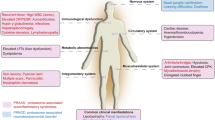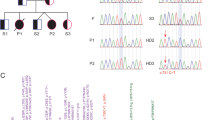Abstract
Aims
Familial partial lipodystrophy (FPLD) is a rare autosomal dominant disorder, mostly due to mutations in lamin A (LMNA) or in peroxisome proliferator-activated receptor gamma (PPARG) genes. In the present study, we aimed to identify and functionally characterize the genetic defect underlying FPLD in an Italian family presenting with several affected individuals in three consecutive generations.
Methods
Mutational screening by direct Sanger sequencing has been carried out on both LMNA and PPARG genes. In silico analyses and functional in vitro studies on transfected cell lines have been also performed to evaluate the biological impact of the identified mutation.
Results
We identified a novel PPARG missense mutation (i.e., PPARγ2 Ile354Val) segregating with FPLD in the study family. In silico analyses and in vitro experiments showed that probably altering the PPARγ2 ligand binding domain conformation, the Ile354Val aminoacid change leads to a significant reduction (i.e., ~ 30–35%) of transcriptional activity in the mutant receptor, with no evidences of a dominant negative effect on the wild-type receptor.
Conclusions
Our present data extend the spectrum of PPARG mutations responsible for FPLD3 and reinforce the notion that even loss of function mutations affecting transcriptional activity to an extent lower than that observed in the case of haploinsufficiency are able to cause a severe FPLD3 phenotype.






Similar content being viewed by others
References
Huang-Doran I, Sleigh A, Rochford JJ, O’Rahilly S, Savage DB (2010) Lipodystrophy: metabolic insights from a rare disorder. J Endocrinol 207(3):245–255. https://doi.org/10.1677/joe-10-0272
Fiorenza CG, Chou SH, Mantzoros CS (2011) Lipodystrophy: pathophysiology and advances in treatment. Nat Rev Endocrinol 7(3):137–150. https://doi.org/10.1038/nrendo.2010.199
Semple RK, Chatterjee VK, O’Rahilly S (2006) PPAR gamma and human metabolic disease. J Clin Investig 116(3):581–589. https://doi.org/10.1172/JCI28003
Carr IM, Camm N, Taylor GR et al (2011) GeneScreen: a program for high-throughput mutation detection in DNA sequence electropherograms. J Med Genet 48(2):123–130. https://doi.org/10.1136/jmg.2010.082081
Prudente S, Flex E, Morini E et al (2007) A functional variant of the adipocyte glycerol channel aquaporin 7 gene is associated with obesity and related metabolic abnormalities. Diabetes 56(5):1468–1474. https://doi.org/10.2337/db06-1389
Di Paola R, Caporarello N, Marucci A et al (2011) ENPP1 affects insulin action and secretion: evidences from in vitro studies. PLoS ONE 6(5):e19462. https://doi.org/10.1371/journal.pone.0019462
Patane G, Caporarello N, Marchetti P et al (2013) Adiponectin increases glucose-induced insulin secretion through the activation of lipid oxidation. Acta Diabetol 50(6):851–857. https://doi.org/10.1007/s00592-013-0458-x
Richards S, Aziz N, Bale S et al (2015) Standards and guidelines for the interpretation of sequence variants: a joint consensus recommendation of the American College of Medical Genetics and Genomics and the Association for Molecular Pathology. Genet Med 17(5):405–424. https://doi.org/10.1038/gim.2015.30
Jarvik GP, Browning BL (2016) Consideration of cosegregation in the pathogenicity classification of genomic variants. Am J Hum Genet 98(6):1077–1081. https://doi.org/10.1016/j.ajhg.2016.04.003
Majithia AR, Tsuda B, Agostini M et al (2016) Prospective functional classification of all possible missense variants in PPARG. Nat Genet 48(12):1570–1575. https://doi.org/10.1038/ng.3700
Wang YX (2010) PPARs: diverse regulators in energy metabolism and metabolic diseases. Cell Res 20(2):124–137. https://doi.org/10.1038/cr.2010.13
Desvergne B, Wahli W (1999) Peroxisome proliferator-activated receptors: nuclear control of metabolism. Endocr Rev 20(5):649–688. https://doi.org/10.1210/edrv.20.5.0380
Spiegelman BM (1998) PPAR-gamma: adipogenic regulator and thiazolidinedione receptor. Diabetes 47(4):507–514
Fajas L, Auboeuf D, Raspe E et al (1997) The organization, promoter analysis, and expression of the human PPARgamma gene. J Biol Chem 272(30):18779–18789
Chandra V, Huang P, Hamuro Y et al (2008) Structure of the intact PPAR-gamma-RXR-nuclear receptor complex on DNA. Nature 456(7220):350–356. https://doi.org/10.1038/nature07413
Molnar F, Matilainen M, Carlberg C (2005) Structural determinants of the agonist-independent association of human peroxisome proliferator-activated receptors with coactivators. J Biol Chem 280(28):26543–26556. https://doi.org/10.1074/jbc.M502463200
Huang-Doran I, Sleigh A, Rochford JJ, O’Rahilly S, Savage DB (2010) Lipodystrophy: metabolic insights from a rare disorder. J Endocrinol 207(3):245–255. https://doi.org/10.1677/JOE-10-0272
Broekema MF, Savage DB, Monajemi H, Kalkhoven E (2019) Gene-gene and gene-environment interactions in lipodystrophy: lessons learned from natural PPARgamma mutants. Biochim Biophys Acta Mol Cell Biol Lipids 1864(5):715–732. https://doi.org/10.1016/j.bbalip.2019.02.002
Jeninga EH, Gurnell M, Kalkhoven E (2009) Functional implications of genetic variation in human PPARgamma. Trends Endocrinol Metab 20(8):380–387. https://doi.org/10.1016/j.tem.2009.04.005
Majithia AR, Flannick J, Shahinian P et al (2014) Rare variants in PPARG with decreased activity in adipocyte differentiation are associated with increased risk of type 2 diabetes. Proc Natl Acad Sci U S A 111(36):13127–13132. https://doi.org/10.1073/pnas.1410428111
Funding
This work was partly supported by the Italian Ministry of Health (Ricerca Corrente 2018-2020 to SP and VT).
Author information
Authors and Affiliations
Contributions
GP, SP and LF designed the study, analyzed data and wrote the manuscript. FV, DS, RB, EB, AV and LS generated and analyzed data. VT analyzed data and helped writing the manuscript. All authors read and commented on the manuscript. LF is the guarantor of this work and had full access to all data in the study and takes responsibility for the integrity of the data and the accuracy of the analysis.
Corresponding author
Ethics declarations
Conflict of interest
The authors declare that they have no conflict of interest.
Human and animal rights disclosure
All procedures followed were in accordance with the ethical standards of the responsible committee on human experimentation (University of Catania and IRCCS Casa Sollievo della Sofferenza, Italy) and with the Helsinki Declaration of 1975, as revised in 2008.
Informed consent
Informed consent was obtained from all patients or their relatives for being included in the study.
Additional information
Managed by Antonio Secchi.
Publisher's Note
Springer Nature remains neutral with regard to jurisdictional claims in published maps and institutional affiliations.
Electronic supplementary material
Below is the link to the electronic supplementary material.
Rights and permissions
About this article
Cite this article
Padova, G., Prudente, S., Vinciguerra, F. et al. The novel loss of function Ile354Val mutation in PPARG causes familial partial lipodystrophy. Acta Diabetol 57, 589–596 (2020). https://doi.org/10.1007/s00592-019-01462-y
Received:
Accepted:
Published:
Issue Date:
DOI: https://doi.org/10.1007/s00592-019-01462-y




